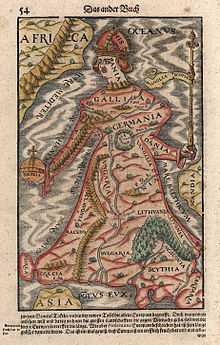Cosmographia (Sebastian Münster)
The Cosmographia by Sebastian Münster (1488 – 1552) from 1544 is the earliest German description of the world.[1]
It had numerous editions in different languages including Latin, French (translated by François de Belleforest), Italian, English, and Czech. The last German edition was published in 1628, long after his death. The Cosmographia was one of the most successful and popular books of the 16th century. It passed through 24 editions in 100 years. This success was due to the notable woodcuts (some by Hans Holbein the Younger, Urs Graf, Hans Rudolph Manuel Deutsch, and David Kandel). It was most important in reviving geography in 16th-century Europe.
His first geographic works were Germania descriptio (1530) and Mappa Europae (1536). In 1540 he published a Latin edition of Ptolemy's Geographia with illustrations. The 1550 edition contains cities, portraits, and costumes. These editions, printed in Germany, are the most valued of the Cosmographias.
Content of the 1544–1598 editions

- Book I - Astronomy, Mathematics, Physical Geography, Cartography
- Book II - England, Scotland, Ireland, Spain, France, Belgium, The Netherlands, Luxembourg, Savoy, Trier, Italy
- Book III - Germany, Alsace, Switzerland, Austria, Carniola, Istria, Bohemia, Moravia, Silesia, Pomerania, Prussia, Livland
- Book IV - Denmark, Norway, Sweden, Finland, Iceland, Hungary, Poland, Lithuania, Russia, Walachia, Bosnia, Bulgaria, Serbia, Greece, Turkey
- Book V - Asia Minor, Cyprus, Armenia, Palestine, Arabia, Persia, Central Asia, Afghanistan, Scythia, Tartary, India, Ceylon, Burma, China, East Indies, Madagascar, Zanzibar, America
- Book VI - Mauritania, Tunisia, Libya, Egypt, Senegal, Gambia, Mali, South Africa, East Africa
Editions of Cosmographia
- German 1544, 1546, 1548, 1550, 1553, 1556, 1558, 1561, 1564, 1567, 1569, 1572, 1574, 1578, 1588, 1592, 1598, 1614, 1628
- Latin 1550, 1552, 1554, 1559, 1572
- French 1552, 1556, 1560, 1565, 1568, 1575
- Italian 1558, 1575
- Czech 1554
-

Map of Nordgau
-

Ingelheim
-

Blemmye, a fantastic creature
-

Frankfurt (Main)
-

Frankfurt (Oder)
-

Map of Germany
-

Map of central and eastern Europe
-

Speyer
-

Skyline of Riga
Literature
- ↑ The New Encyclopaedia Britannica, 1974, ISBN 0-85229-290-2
- Karl Heinz Burmeister: Sebastian Münster - Versuch eines biographischen Gesamtbildes. Basler Beiträge zur Geschichtswissenschaft, Band 91, Basel und Stuttgart 1963 und 1969.
- Karl Heinz Burmeister: Sebastian Münster - Eine Bibliographie. Wiesbaden 1964.
- Hans Georg Wehrens: Freiburg in der „Cosmographia“ von Sebastian Münster (1549); in Freiburg im Breisgau 1504 - 1803, Holzschnitte und Kupferstiche. Verlag Herder, Freiburg 2004, S. 34 ff. ISBN 3-451-20633-1.
- Günther Wessel: Von einem, der daheim blieb, die Welt zu entdecken - Die Cosmographia des Sebastian Münster oder Wie man sich vor 500 Jahren die Welt vorstellte. Campus Verlag, Frankfurt 2004, ISBN 3-593-37198-7.
- Ludwig Geiger (1886), "Münster, Sebastian", Allgemeine Deutsche Biographie (ADB) (in German) 23, Leipzig: Duncker & Humblot, pp. 30–33
- Claus Priesner (1997), "Münster, Sebastian", Neue Deutsche Biographie (NDB) (in German) 18, Berlin: Duncker & Humblot, pp. 539–541
External links
| Wikimedia Commons has media related to Cosmographia. |
- Sebastian Münster in the German National Library catalogue
- "Cosmographia (Sebastian Münster)". Biographisch-Bibliographisches Kirchenlexikon (BBKL) (in German).
- Cosmographia (Sebastian Münster) in German, French and Italian in the online Historical Dictionary of Switzerland.
- Artikel in der TRE
- Lateinische Werke im Internet
- Wer war Sebastian Münster? - Umfangreiche Dokumentensammlung des Sebastian-Münster-Gymnasiums in Ingelheim.
- Sebastian Münster, La Cosmographie universelle online excerpts
- His Map of Asia (1544 AD), Tabula orientalis regionis, Asiae scilicet extremas complectens terras & regna
- Historic Cities: Sebastian Münster
- http://www.uni-giessen.de/gloning/at/schreckenfuchs_1553_oratio-funebris-de-obitu-sebastiani-munsteri.pdf